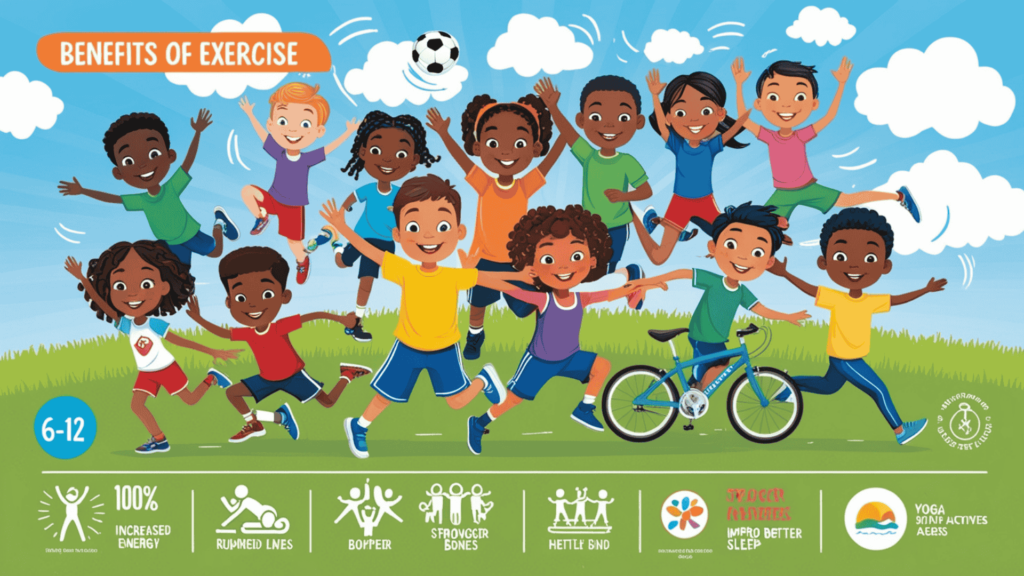Greetings, I’m Hassan! Do you also feel that muscles can only built in expensive gyms not with home workouts? But trust me, it’s just a misconception, building muscle and bone strength is easier than you think.
In this blog post, I’m sharing with you some fun, creative home workouts that are affordable, and require no fancy equipment. Just imagine turning your living room into a fitness zone, that is filled with laughter and dance parties! Let’s explore how you can create workout routines in your comfort zones that are engaging and effective, so they can thrive in every aspect of life.
Table of Contents

Benefits of Exercise for Kids Home Workouts
Every person should know that regular exercise is vital for kids’ overall health. This helps in:
- Weight management
- Strengthening muscles and bones
- Reducing the risk of diseases
- Enhances motor skills
- Boosts brain development
- Improves cognition, memory, and mood.
The kids involved in physical activity have social skills and believe in teamwork. It also promotes better sleep and behavior. An important factor is the habits that are established in childhood always lay the foundation for lifelong wellness and healthy lifestyles.
Following are some benefits with little description of the benefits of exercise:
|
Benefit |
Description |
|
Improved Physical Health |
Exercise will:
|
|
Enhanced Cognitive Function |
Physical activity boosts:
|
|
Better Mood and Mental Well-being |
Regular exercise will:
|
|
Increased Energy Levels |
Physical activity increases
|
|
Weight Management |
Regular exercise helps maintain
|
|
Improved Sleep |
Exercise promotes:
|
|
Team Building |
Group exercises and sports activities encourage;
|
|
Self-esteem Boosted |
Your child’s confidence will be boosted in
|
|
Development of Motor Skills |
Exercises help in the development of:
|
|
Reduced Chronic Diseases |
Regular physical activity lowers the risk of:
|
Fun and Creative Home Workouts
Tell your kids that exercise is about looking good and a fundamental building block for a healthy and happy life. Just like your kids need the right foods to grow, in the same way, they need physical activity to develop strong bodies with sharp minds.
Basically, exercise is a critical investment that you do for your child’s overall health and well-being. It has multiple benefits as it helps them grow strong, think sharp, and feel good.
Following are some creative, fun exercises discussed:
Obstacle Course
Create a fun obstacle like jumping over, and balancing on various objects like:
- Pillows
- Cushions
- Chairs
Dance Party
Put on lively music and have a dance party where kids can dance freely and express themselves through movement.
Scavenger Hunt
Create a scavenger hunt with physical challenges, such as:
- Finding items hidden around the house
- Completing tasks like jumping jacks or squats.
Animal Yoga
Guide kids through a series of yoga poses inspired by animals, such as:
- Cat-cow stretch
- Cobra pose
- Downward dog
- Tree pose.
Hopscotch
Draw a hopscotch grid. It can be drawn on the floor with chalk or tape and have kids jump, and balance as they play the game.
Balloon Volleyball
You can blow up balloons and have kids play volleyball using their hands. This will encourage movement and coordination in your children.
Simon Says
You should play a game of Simon Says. It can be played with physical actions like:
- Touching toes
- Hopping on one foot
- Doing a silly dance move.
Fitness Dice
You should create a fitness dice with different exercises on each side, and have kids roll the dice to determine their workout. Following are some exercises:
- Jumping jacks
- Lunges
- Bear crawls
Indoor Bowling
Use empty bottles set up makeshift bowling pins and have kids roll a soft ball to knock them down. This will promote hand-eye coordination and strength.
Nature Walk
You should take your kids on a nature walk, explore, move your body, and appreciate the outdoors
Building a Routine
So you’ve unlocked a treasure trove of creative home exercises! But how do you turn this into a regular habit for your kids? Here’s a guide to building a fun and sustainable exercise routine:
Set Realistic Goals
- Start Small: Don’t overwhelm and begin with short bursts of activity. It should be of 15-20 minutes, 2-3 times a week. As they get fitter, gradually increase in duration and frequency.
- Focus on Fun: Your goal should be to make exercise enjoyable. For this, choose the activities your child loves. You can also create a mix of different exercises to keep things interesting.
Schedule It
- Pick a Time that Works: Consider your child’s schedule and set the workouts accordingly. This can be after school or during a weekend playdate.
- Treat it Like an Appointment: Consistency is key so stick to it as much as possible!
Keep it Engaging
- Theme it Up: You should sit with your children and choose a weekly theme for the workouts. It could be:
- “Animal Olympics”
- “Underwater Adventure”
- Play Music: Music energizes your workouts and makes them more enjoyable. So, play music and enjoy together.
- Reward Progress: You should celebrate every milestone and achievement. You can give your children small rewards like
- Stickers
- Special treat
- Extra screen time
Remember
- Focus on Effort, Not Perfection: In the beginning, don’t expect from them to be perfect just encourage your child to give their best effort.
- Be Flexible: Understand your child, there will be days when your child might not be in the mood to exercise. In these scenes, you should:
- Be Flexible
- Reschedule
- Choose a shorter, less strenuous activity.
Have Fun!
Laughing and enjoying are the most important things, enjoy every moment and achieve the goals you’ve set for yourself.
By following the above tips, you can transform your home into a fun and effective fitness zone, and build strong muscles and bones in your kids. And create lasting memories together!

Motivating Kids to Stay Active
- Lead by Example: Your children mostly mimic your behavior. Show energy for physical activity, be their positive role model, and inspire your kids to stay active.
- Involve Friends and Family: Organize activities that will involve your friends and family members or the people you enjoy with. Our social interactions can make us physically active and also enjoyable and motivating.
- Create Challenges: You should create friendly challenges and competitions. This will promote friendly rivalry and also encourage your kids to improve their skills.
- Make It Accessible: Ensure facilities for the physical activities of your children. Remove barriers if any and make it easy for children to engage in playing actively.
- Limit Screen Time: Set reasonable limits on their screen times. In this way, you can free up more time for physical activity. Encourage outdoor play as compared to screen-based activities.
- Focus Health Benefits: Educate your children about the importance of staying active for their:
- Physical health
- Energy levels
- Mood
- Overall well-being.
Conclusion
In conclusion, I want to say that it is all up to you to make those home workouts enjoyable and beneficial for your kids’ muscles and bones. You need to promote movement so your children can develop strength, flexibility, and coordination.
The activities will not only contribute to the physical fitness of your child but also they’ll adopt healthy habits and a positive attitude towards exercise from a young age.
Your focus should be on variety, safety, and encouragement. In this way, can create an environment where kids thrive physically and they’ll enjoy staying active without the need for a gym.
FAQ
Q: Are home workouts important for my kids?
A: Yes, home workouts are crucial for kids. They promote:
- Physical fitness
- Strengthen muscles and bones
- Improve coordination and balance
- Boost mood and confidence
- Instill healthy habits from a young age.
Q: How can my child stay motivated to exercise at home?
A: The workouts should be fun and there should be varieties. Involve your kids in:
- Choosing activities
- Set achievable goals
- Offer rewards or incentives
- Workout together as a family
- Praise their efforts and progress.
Q: Tell me some safety precautions.
A: The following are some safety precautions:
- Always warm up before exercising
- Ensure proper technique and form
- Use age-appropriate exercises and equipment
- Provide supervision
- Stay hydrated
- Listen to your child’s cues if they feel discomfort.
Q: For how many times should kids do home workouts?
A: Kids should engage in physical activity for at least 60 minutes every day. This can include a mix of:
- Structured workouts
- Active play
- Sports activities.
Q: Are there any nutritional recommendations that will support the workouts of my child?
A: Two factors are extremely important, they are:
- Encourage a balanced diet rich in fruits, vegetables, lean proteins, whole grains
- Plenty of water to fuel their workouts, aid in recovery, and promote overall health and well-being.




